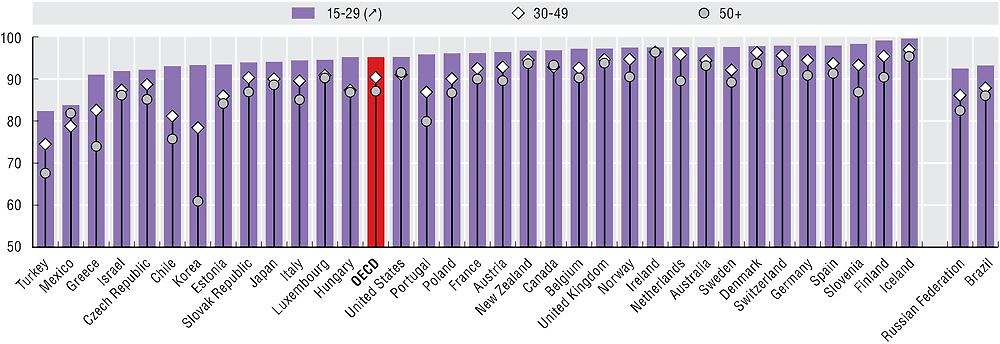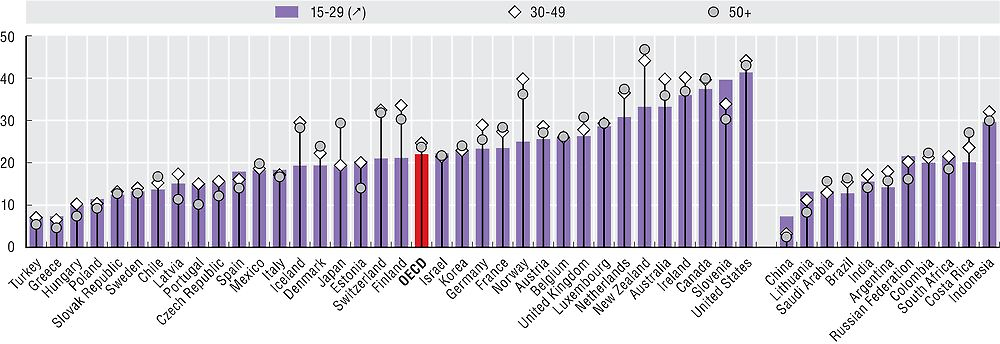Social networks
Social networks consist of a group of individuals interacting with each other, be it in person or virtually. Social networks and connectedness have been shown to be important for a variety of outcomes. Loneliness has been shown to be more prevalent amongst those on the edge of social networks and has been shown to be detrimental to health and increase mortality rates, particularly for older people (Cacioppo et al., 2011).
Young people tend to have a higher level of social support than older age groups. On average across the OECD 93% of 15-29 year-olds report having a relative or friend they can count on to help them if they were in trouble (Figure 7.13). This compares to 89% of those aged 30-49 and 87% of those over 50. In most OECD countries at least 90% of youth report having family or friends to turn to, just Turkey and Mexico fall below this level (83 and 84% respectively). Turkey and Korea both experience relatively low levels of social support for older age groups with only 61% of Korean and 68% of Turkish persons over 50 reporting having someone to turn to in times of need. Iceland, Ireland and Denmark have some of the highest rates of social supports across the different age groups.
This higher level of social support amongst young people may, in part, be due to their higher level of online connectedness. Online social networking by young people has been show to allow them to explore interests outside of their physical social network and teach them about social norms (Mizuko et al., 2009). 16-24 year-olds are 1.4 times more likely to engage in online social networking than the overall (16-74) population (Figure 7.14). On average across the OECD 89% of youth use online social networks, ranging from 53% in Mexico to 97% in Iceland. Online social connectedness is, of course, linked to internet access and the owning of a smartphone. 35% of individuals in Mexico report owning a smartphone compared to over 90% in countries like the United States the United Kingdom and Canada (PEW, 2016). Only 26% of households in Mexico report having access to the internet compared to 95% of households in Iceland (OECD, 2016).
Volunteering, as well as providing a contribution to society, has been shown to increase the wellbeing of volunteers themselves (Meier and Stutzer, 2007). Just over one-fifth of young people across the OECD report volunteering in the past month (Figure 7.15). This is slightly lower than for those aged 30 and over. Participation in volunteer activities varies greatly across the OECD. Countries like Greece, Turkey and Hungary tend to have low volunteering rates with 10% or less of adults volunteering their time. At the other end of the spectrum a large proportion (in excess of one-third) of adults in New Zealand, the United States and Ireland volunteered in the last month.
Data on social support and volunteering in an organisation comes from the Gallup World Poll where the questions asked to respondents are respectively: “If you were in trouble, do you have relatives or friends you can count on to help you?” and “Have you done any of the following in the past month? How about volunteered your time to an organisation?”. The Gallup World Poll is conducted in more than 150 countries around the world based on a common questionnaire. With few exceptions, all samples are probability-based and nationally representative of the resident population aged 15 years and over in the entire country, including rural areas. While this ensures a high degree of comparability across countries, results may be affected by sampling and non-sampling error, and variation in response rates; for example, data, especially for youth, should be interpreted carefully. Rates refer to people who answered “yes” and include Don’t know” and “Refused” in the denominator.
Data on online activities among Internet users are from the OECD Information and communication technology (ICT) database. The part for ICT Access and Usage by Households and Individuals is based on Eurostat Statistics on Households and Individuals for the OECD countries that are part of the European Statistical system. Otherwise for non EU countries the information is based on an OECD data collection where the data originate from National Statistical Offices official surveys.
Further reading
Cacioppo, J. et al. (2011), “Social isolation”, Annals of the New York Academy of Sciences, Vol. 1231, pp. 17-22.
Mizuko, I. et al. (2009), “Living and Learning with New Media: Summary of Findings from the Digital Youth Project”, MacArthur Foundation Reports.
OECD (2016), “Internet access (indicator)”, https://doi.org/10.1787/69c2b997-en (accessed 24 May 2016).
OECD (2015), OECD Science, Technology and Industry Scoreboard 2015: Innovation for Growth and Society, OECD Publishing, Paris, https://doi.org/10.1787/sti_scoreboard-2015-en.
Pew Research Center (2016) “Smartphone Ownership and Internet Usage Continues to Climb in Emerging Economies”, www.pewglobal.org/files/2016/02/pew_research_center_global_technology_report_final_february_22__2016.pdf.
Figure notes
Figure 7.14: No data available for the United States and for 16-24 year-olds in Canada and Japan. Data refer to 2014 except for Australia and Israel: 2013 and Canada and New Zealand: 2012.

Source: OECD (2015), How’s Life 2015 – Measuring Well-being, Gallup World Poll, www.gallup.com/services/170945/world-poll.aspx.

Source: OECD ICT Database; Eurostat, Information Society Statistics Database, March 2016.

Source: Gallup World Poll, www.gallup.com/services/170945/world-poll.aspx.
